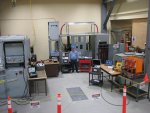StaySafe
Member
- Location
- Tucson, AZ
Looking for guidance on hipot (dielectric withstand) testing and approach boundaries.
We hipot test completed assemblies in the open (i.e., no insulated enclosure) with 2000 VDC at 5 mA. I can’t be specific about the type of assembly, but they have metal frames so the whole thing could be potentially energized if it fails.
For the testing, the completed assembly power plug is inserted into an adapter connected to the hipotter and the hipot test is performed for about a minute. The hipot test operator does not interact with the device under test during testing.
Is there any exception to the approach boundaries in 70E (2018) since the current is so low? Or is 2000 VDC, 2000 VDC no matter the current so table 130.1(D)(b) applies regardless? My past experience with hipot had a higher current, so boundaries were a no-brainer.
The minimal current appears to make this a low risk test – please correct me if you feel differently. I would really like your rationale one way or another since this is currently a debate in my company – basically, “5 mA won’t hurt you so the boundaries aren’t needed.”
If it makes a difference, we use the Associated Research 3765. The hipot tester is capable of 7.5 mA maximum with DC.
Thanks.
We hipot test completed assemblies in the open (i.e., no insulated enclosure) with 2000 VDC at 5 mA. I can’t be specific about the type of assembly, but they have metal frames so the whole thing could be potentially energized if it fails.
For the testing, the completed assembly power plug is inserted into an adapter connected to the hipotter and the hipot test is performed for about a minute. The hipot test operator does not interact with the device under test during testing.
Is there any exception to the approach boundaries in 70E (2018) since the current is so low? Or is 2000 VDC, 2000 VDC no matter the current so table 130.1(D)(b) applies regardless? My past experience with hipot had a higher current, so boundaries were a no-brainer.
The minimal current appears to make this a low risk test – please correct me if you feel differently. I would really like your rationale one way or another since this is currently a debate in my company – basically, “5 mA won’t hurt you so the boundaries aren’t needed.”
If it makes a difference, we use the Associated Research 3765. The hipot tester is capable of 7.5 mA maximum with DC.
Thanks.

